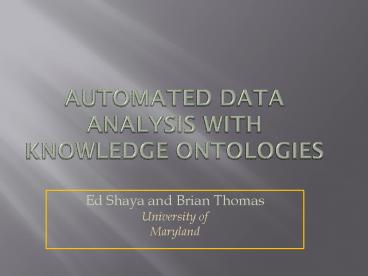Automated Data Analysis with Knowledge Ontologies - PowerPoint PPT Presentation
1 / 12
Title:
Automated Data Analysis with Knowledge Ontologies
Description:
The VxOs are working toward having all of the distributed tabular data described ... paths can be presented graphically and then pruned and adjusted by the scientist. ... – PowerPoint PPT presentation
Number of Views:41
Avg rating:3.0/5.0
Title: Automated Data Analysis with Knowledge Ontologies
1
Automated Data Analysis with Knowledge Ontologies
- Ed Shaya and Brian ThomasUniversity ofMaryland
2
Web Ontology Language Visual Programming
Environment OWLVIPER
- The VxOs are working toward having all of the
distributed tabular data described semantically
(UCDs and data models) and mappings are being
created between different specialized
vocabularies. - An effort is beginning for the descriptions of
what each software tool (service) does and the
form of its inputs and outputs. - If data is sufficiently self describing, the
system can suggest appropriate operations.
(think, .pdf suffix indicates, use acroread,
etc). - Now, what if you can describe, in a computer
readable way, your goals (the imagined end-
process data) for the information that you want?
3
Goal Driven Automation
- Paths from the goals to the existing data (even
if still in datacenters) can be discovered by
automated analyses of transformations. These
paths can be presented graphically and then
pruned and adjusted by the scientist. - Preferred pathways can be stored (compressed)
as a new operation and reused for future uses. - Successful methods can become templates (or
WebServices) for others. - Data from repositories can be well constrained to
the needs and fused together logically.
4
Functionality of OWLViper
- Visual Non-Programming Interface
- High level interface between scientist and
analysis software through a canvas to find and
analyze data. - Query distributed data centers for derived data
using technical terms (not datacentric), as well
as analyze and visualize. - User draws flow diagram executes common code
with java wrappers, Jython or WebService on data. - Flow diagram can be stored, named, and reused.
- Various levels of autonomy
- Lowest level manual creation of a flow diagram
- Highest level state the goal and let it rip via
OWL knowledge base. JENA and Pellet Reasoners. - Scientific - handle unit conversions and error
propagation, of course.
5
Ontology (OWL)
- Functions and data are placed in class structure
(not a strict hierarchy) plus properties or
relationships.
Code
relation
Class1
output
input
Operation
inverse
6
OWLViperLayersThe Data Hunter.
7
(No Transcript)
8
(No Transcript)
9
Example Operation
- Select property, allowed operations appear.
- Select operation, resultant data structure
appears.
10
OWL Flow description
- The Flow on the Work Canvas can be fully
described by OWL. Thus it can be saved in XML
format and can define higher-level operations.
It can also be created from scratch using N3 - Supercluster_a name Hercules hasGalaxy
spiralGalaxy_a. - spiralGalaxy_a hasMeasurement dismod_a, W20.
- dismod_a hasNumericValue value_a hasUnits mag.
- value_a constraint greaterThan number 10..
- dismod2distance hasInput dismod_a hasOutput
distance. - Parser presumes
- Distance_a implies distance_a a phydistance.
Etc. - Operation output goes to new data object.
11
Software repository
- Building software repository
- Bundle compiled and wrapped software ready to run
through the OWLViper. - Example data.
- Ontologically classed
12
Conclusion
- We have created an application for semantically
aware discovery and analysis of many object, many
property scientific data. - This infrastructure can work with almost any
ontology from most fields of science. - We have prototyped how OWL can describe
scientific data, the operations on trees of
Class/property/Class objects and therefore
multi-pathways workflows. - As a bonus, we developed top level Ontology for
- General science, Astronomy, Physics, Statistics,
Instrumentation, Computation, Chemistry,
Quantity, and Units































